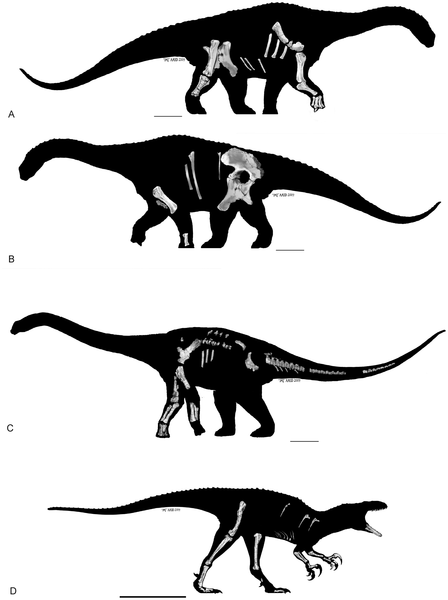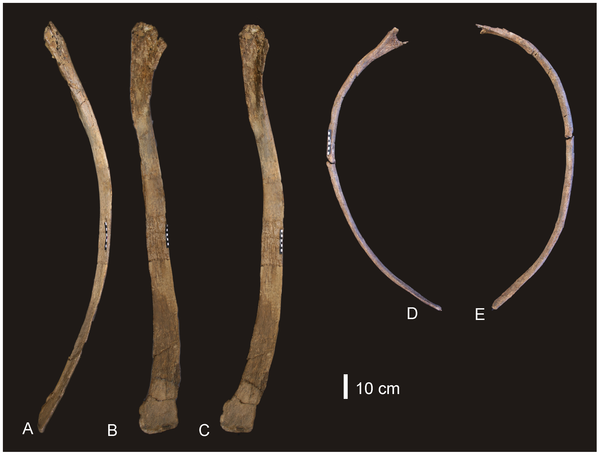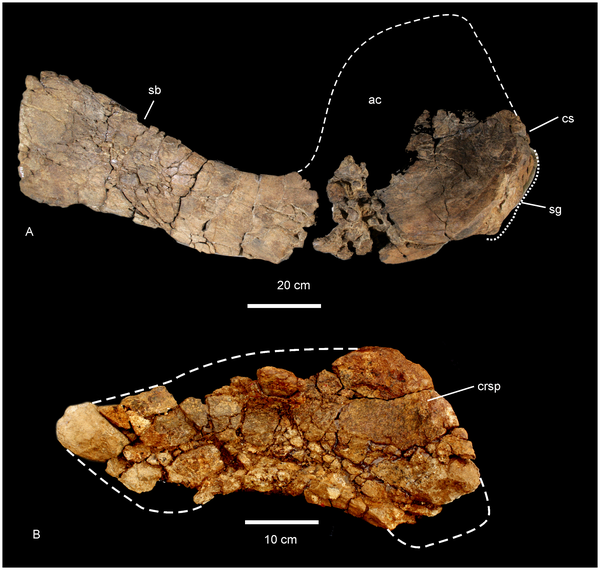Background
Australia’s dinosaurian fossil record is exceptionally poor compared to that of other similar-sized continents. Most taxa are known from fragmentary isolated remains with uncertain taxonomic and phylogenetic placement. A better understanding of the Australian dinosaurian record is crucial to understanding the global palaeobiogeography of dinosaurian groups, including groups previously considered to have had Gondwanan origins, such as the titanosaurs and carcharodontosaurids.
Methodology/Principal Findings
We describe three new dinosaurs from the late Early Cretaceous (latest Albian) Winton Formation of eastern Australia, including; Wintonotitan wattsi gen. et sp. nov., a basal titanosauriform; Diamantinasaurus matildae gen. et sp. nov., a derived lithostrotian titanosaur; and Australovenator wintonensis gen. et sp. nov., an allosauroid. We compare an isolated astragalus from the Early Cretaceous of southern Australia; formerly identified as Allosaurus sp., and conclude that it most-likely represents Australovenator sp.
Conclusion/Significance
The occurrence of Australovenator from the Aptian to latest Albian confirms the presence in Australia of allosauroids basal to the Carcharodontosauridae. These new taxa, along with the fragmentary remains of other taxa, indicate a diverse Early Cretaceous sauropod and theropod fauna in Australia, including plesiomorphic forms (e.g. Wintonotitan and Australovenator) and more derived forms (e.g. Diamantinasaurus).

Silhouettes of the three new dinosaurs showing the material currently known from their respective holotypes.
A–B. Diamantinasaurus matildae gen. et sp. nov. (AODF 603); A. Right side, B. Left side. C. Wintonotitan wattsi gen. et sp. nov. (QMF 7292); Left view. D. Australovenator wintonensis gen. et sp. nov. (QMF 7292); Right view. Artwork: T. Tischler, Australian Age of Dinosaurs Museum of Natural History.
doi:10.1371/journal.pone.0006190.g002

Dorsal ribs of Diamantinasaurus matildae.
Mid-dorsal rib in lateral (A), anterior (B) and posterior (C) views. Posterior dorsal rib in posterior (A) and anterior (B) views.
doi:10.1371/journal.pone.0006190.g003

Scapula and sternal plate of Diamantinasaurus matildae.
Right scapula in lateral view (A). Left sternal plate in ventral view (B). Abbreviations: ac, acromial blade; crsp, cranial ridge of sternal plate; cs, coracoid suture; sb, scapular blade; sg, scapula glenoid. Dashed line indicates suggested area missing from specimen.
doi:10.1371/journal.pone.0006190.g004
For Article details and more pictures:
Citation: Hocknull SA, White MA, Tischler TR, Cook AG, Calleja ND, et al. (2009) New Mid-Cretaceous (Latest Albian) Dinosaurs from Winton, Queensland, Australia. PLoS ONE 4(7): e6190. doi:10.1371/journal.pone.0006190
Editor: Paul Sereno, University of Chicago, United States of America



 February 1st, 2014
February 1st, 2014  Riffin
Riffin  Posted in
Posted in  Tags:
Tags: 